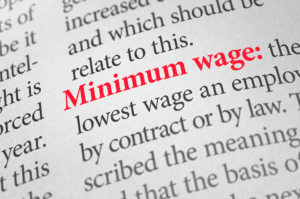
 The Current Minimum Wage Rates
The Current Minimum Wage Rates
Prior to enacting the Fair Labor Standards Act in 1938, the United States didn’t have a minimum wage. Employers could pay their workers whatever rate they chose. Since enacting the law, however, the federal and state governments have dictated a minimum wage to employers. While the least acceptable wage is established by the federal government, individual states may require businesses operating within that jurisdiction to adhere to a higher wage requirement. Read more about the aspects of employment covered by law and the FLSA Regulations and computing overtime pay.
Nationally, the minimum wage is $7.25 per hour, and the majority of states do adhere to that hourly rate. States with a significantly higher cost of living do try to compensate by also establishing a higher minimum wage. California, for instance, has enacted a $10.50 hourly minimum wage. While some cities in the state have established a minimum pay rate that’s even higher than the state minimum. As of January 1, 2018, the state of California will add a .50 cent increase to their minimum wage.
Each consecutive year will see another increase of $1.00 to bring the minimum wage to $15 per hour by 2022.
San Francisco will see a minimum wage of $15 by the start of 2018 and Los Angeles will see the same wage requirement for employees of large companies by the year 2020.
Outside of California, Montgomery County in Maryland has raised their minimum wage from $10.75 to $11.50, an increase that was established in July of this year. Chicago pays an $11 minimum wage with plans to bolster that rate up to $13 by 2019. Elsewhere in Cook County, plans to increase the minimum wage to $13 will take effect by 2020.
When Can a Company Elude the National and State Minimum Wage Requirements?
While state and local governments may allow for certain changes to the federally mandated minimum wage laws, not all businesses must comply with the minimum wage laws at any level. For example, an employee who receives tips is only required to be paid a $2.13 minimum wage under federal law. The stipulation is that the amount received in tips, plus the $2.13 hourly wage, must equate to the standard $7.25 hourly requirement. In cases where the total does not equate the federal minimum wage of $7.25, the employer is required to make up the difference.
For workers under the age of 20, employers must pay $4.25 per hour. This is regardless of how much the employee receives in tips. This requirement applies to the first consecutive 90 days of employment. Following this probationary period, the worker must be paid $5.85 per hour.
Many are exempt from the minimum wage law. Some examples being babysitters working a casual schedule, companions for elderly persons, and fishing workers. In cases where the minimum wage law does apply, it’s up to the worker to ensure that the employer is paying the appropriate wage. If there is a discrepancy, a complaint can be filed with the Compliance Section of the U.S. Department of Labor Employment Standards Administration Wage and Hour Division.




